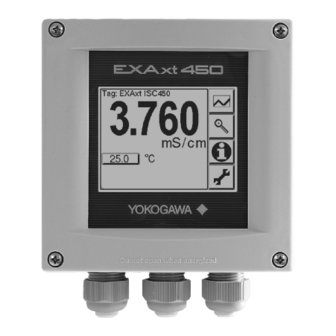
Summarization of Contents
Document Preface and Safety Information
Electrostatic Discharge Precautions
Precautions against damage to electronic components from static electricity.
Installation and Wiring Guidelines
Guidelines for proper installation and wiring of the EXAxt converter.
Safety and Modification Precautions
Safety measures for using the product and avoiding unauthorized modifications.
Battery Disposal Instructions
Instructions for disposing of batteries in compliance with EU directives.
Introduction to EXAxt ISC450G Converter
Instrument Inspection Upon Delivery
Procedures for inspecting the instrument upon delivery for damage or discrepancies.
EXAxt Converter Application Overview
Overview of the EXAxt converter's intended uses in industrial settings.
EXAxt Converter Installation and Wiring Guide
Installation Site and Dimensions
Guidelines on physical placement, mounting, and overall dimensions for installation.
Wiring Connections for EXAxt Converter
Instructions for connecting electrical wires to the converter terminals and glands.
Power Supply Wiring
Detailed steps for connecting the AC or DC power supply to the instrument.
Contact Signal Wiring
Procedures for connecting the relay contacts for output and input signals.
mA Output Signal Wiring
Guidance on connecting the analog 4-20 mA output signals.
Sensor Wiring
Instructions for connecting the conductivity sensor cable to the converter.
EXAxt ISC450G Operation Guide
Main Display Functions Overview
Explanation of the information shown on the main display screen.
Viewing Trending Graphics
How to view graphical representations of measured data over time.
Accessing Detailed Information
Accessing detailed diagnostic information and parameter values.
Information and Status Reports
How to access status reports, error explanations, and remedies.
Accessing Setup and Commissioning
Navigation to the setup, calibration, and commissioning menus.
Switching Primary and Secondary Display Values
Switching between primary and secondary process values on the main display.
Navigating the Menu Structure
Understanding how to navigate through the device's menu system.
Commissioning Menu Structure
Sensor Configuration Settings
Settings related to measuring units, cell constant, and process measurement selection.
Temperature Settings Configuration
Configuration of temperature sensor type and units for compensation.
Temperature Compensation Setup
Setting up automatic or manual temperature compensation methods.
Calibration Settings Configuration
Defining limits, stabilization time, and interval for calibration procedures.
Concentration Measurement Setup
Setting up concentration measurement and custom tables for conversion.
mA Output Setup and Configuration
Configuring output functions, control modes, and simulated outputs for mA signals.
Contact Output Setup and Functions
Defining functions for alarm, hold, fail, and simulation for contact outputs.
Fail Configuration for Contacts
Configuration options for fail-safe contacts and fail situation handling.
Simulating Output Signals
Setting up simulated output signals for testing contact or percentage outputs.
Input Contact Configuration
Configuration of input contacts for functions like range switching.
Error Handling and Configuration
Setting up how the instrument reports and handles errors (FAIL, WARN, OFF).
Logbook Setup and Management
Setting up which events are logged and how logbooks are managed.
Advanced Setup Options
Configuring defaults, tag, passwords, date/time, and HART network settings.
Display Customization Settings
Customizing the main display, additional text, trend graph axes, and auto-return.
EXAxt Converter Calibration Procedures
Pre-Calibration Checks and Considerations
Essential checks and considerations before performing calibration procedures.
Manual Cell Constant Calibration
Manual adjustment of the cell constant for sensor tuning or recalibration.
Automatic Cell Constant Calibration
Automatic calibration using standard methods and lookup tables.
Air (Zero) Calibration Procedure
Performing a zero-point calibration in air to compensate for cable capacitance.
Sample Calibration Method
Calibrating using process samples for laboratory analysis or in-situ measurements.
Temperature Coefficient Calibration
Calibrating the temperature coefficient for accurate compensation.
Temperature Measurement Calibration
Adjusting the temperature measurement for accuracy.
Using Hold Function During Calibration
Using the HOLD function to freeze output signals during calibration.
EXAxt Converter Maintenance Guide
Periodic Converter Maintenance
Routine checks and cleaning for the converter's display and enclosure.
Periodic Sensor Maintenance
General advice on sensor maintenance and troubleshooting.
Sensor Cleaning Methods
Recommended cleaning agents and procedures for the sensor.
LCD Display Adjustment
Adjusting the contrast of the LCD display.
EXAxt Converter Troubleshooting Guide
General Troubleshooting Overview
Overview of the EXAxt's self-diagnostic features and error reporting.
Calibration Validity Check
How the instrument checks the validity of calibration adjustments.
Predictive Maintenance Features
Utilizing stored data for predicting maintenance needs.
Addressing Poor Calibration Technique
Identifying and correcting common errors in the calibration process.
Understanding Error Displays and Actions
Understanding error messages and the corresponding actions or system responses.
Appendices and Reference Information
Appendix 1: Temperature Compensation Details
Details on how temperature affects conductivity and compensation methods.
Appendix 2: Temperature Compensation Matrix
Information on using matrix tables for advanced temperature compensation.
Appendix 3: Conductivity Calibration Solutions
Recommended solutions and their conductivity values for calibration.
Appendix 4: Measurement Principle Explained
Explanation of the inductive coupling measurement principle used by the sensor.
Appendix 5: HART HHT Menu Structure
Menu structure for using the HART handheld communicator.
Appendix 6: Control Drawing for FM Approval
Wiring diagrams and parameters for FM approval.

















Need help?
Do you have a question about the EXAxt 450 and is the answer not in the manual?
Questions and answers